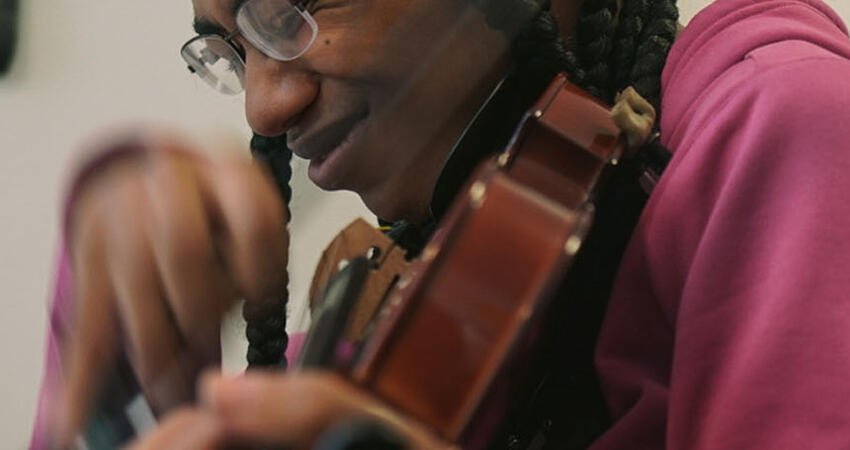
Youth LGBTQ Housing: The Center on Halsted’s Youth Housing Initiative
by Martha Fedorowicz
Walking down Halsted Street in Chicago’s Boystown neighborhood, it’s impossible not to notice the striking glass facade of the Center on Halsted, the Midwest’s largest LGBTQ social service agency. Inside is a hubbub of activity—the center receives nearly 1,000 visitors per day.
When the center was selecting an architectural firm to construct their new building in 2007, they carefully selected a design that would send a strong message to the surrounding community and to the people they served, “that LGBTQ people will no longer reside behind a curtain but will be visible for the world to see.” While the building’s exterior models the center’s desire for visibility in the community, the building’s interior models the type of community spaces desired by those that visit the center—rooms that are open and inviting and hallways that serve as “main streets” where people from diverse groups can meet and interact.
The same year that the Center on Halsted opened its new building, it also put a new program into motion to serve its youth population in ways that it had long dreamed of. “There had always been plans to do special programming for homeless LGBTQ youth,” said Greg Storms, the director of youth programs at Center on Halsted. “A significant portion of our clientele were people experiencing homelessness, especially youth. Even in the 1970s and 1980s, there were hotlines for people being kicked out of their homes for coming out. The need has been known.”
After launching an aggressive fundraising campaign, the center looked for a site to launch a Youth Housing Initiative to house an initial cohort of 10 young people. They struggled to find an appropriate site on the South Side of the city, where there was a concentration of young people in need of services and support, and instead settled for renting units in a building on the North Side. Unfortunately, the new North Side location presented some barriers that didn’t align with the center’s model of support for the youth. “We didn’t realize when we signed the papers that it was a sober living space,” said Storms. “Many of our young folks have experienced significant trauma and utilize marijuana and alcohol as coping mechanisms. Our case workers help them to reduce usage, but for our housing participants at the time, that was a huge challenge. And so we decided to look for a different space.”
The center chose to move the youth to new apartments rented from Preservation of Affordable Housing on the South Side of Chicago. In addition to a fully furnished studio or one-bedroom apartment, the center’s clients receive $75 per month in food support, weekly transportation passes, and a stipend for laundry. The center’s staff also works with the youth, who are between 18 and 27 years old, to help them find a job within their first 90 days in housing. Once they have a job, they are required to put 30 percent of their monthly income into a savings account that they can access when they exit the housing program. “We take that money and put it into a savings account for them so they learn how to budget for rent and bills. When they move out, they get that money back and can use it to pay for a security deposit on their own place.” In exchange for these services, the young people are required to participate in weekly case management and monthly community-based programming and to go through intake with the general youth program.
The fully developed Youth Housing Initiative was the culmination of a two-year research process. According to the Youth Housing Initiative’s website, “Charrettes were convened with funders, issue experts, service providers, potential partner agencies, and at-risk young people themselves.” Center on Halstead also drew heavily on its relationships with other housing organizations and community partner collectives that focus on homelessness. “We created focus groups with individuals and representatives from those organizations on what it means to start a housing program and what is needed. We also brought in youth to learn what they find most necessary,” said Storms. “They have insights you’ll never think about. Having their current perspectives can help alleviate a lot of tension later on.”
Although the program has been operating since 2016, it is still a work in progress and continues to evolve as the center learns how best to support the youth. “Our first year was a beta year,” said Storms. “We got a lot of great information to improve the program. We learned that there needs to be a middle ground of flexibility and stability for program participants—flexible enough to meet their life needs and experiences, but not going so far as to not have any expectations for them.” Although the program initially had relatively few requirements, the center eventually moved to a more structured format for the program as a way to enforce accountability and ensure that program participants were meeting goals and progressing toward permanent housing after their two years in the program.
As part of their continued learning and evolution, Center on Halsted hired an external evaluator to extensively evaluate the program in 2017. The center also tracks participants’ success on various outcomes, including behavioral health and self-esteem, education, employment, socialization opportunities, and access to benefits. And they continue to collect program design input from the youth to see what needs to be changed and improved.
For more information on housing for LGBTQ people, please see our recent blog post on reducing housing instability among LGBTQ Americans.
Thanks to Greg Storms at the Center on Halsted, who provided quotes and context for this article. All opinions or errors should be attributed to How Housing Matters alone.
Photo by Maura Friedman for the Urban Institute


